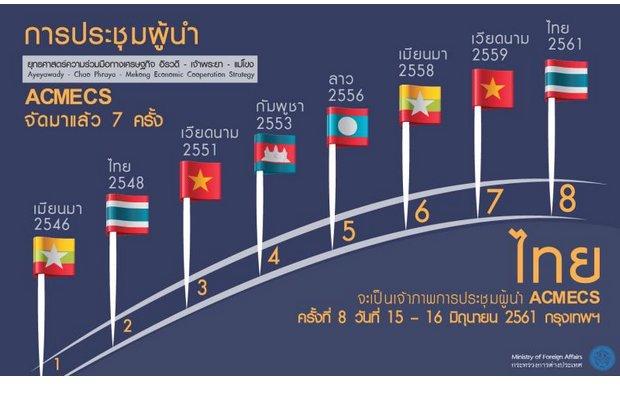
Renewed schemes for the region's three great rivers -- under the Ayeyawady-Chao Phraya-Mekong Economic Cooperation Strategy (Acmecs) -- are making a comeback after some soul-searching amid a plethora of connectivity plans. Bangkok will host the 8th Acmecs summit this Friday and Saturday.
The Acmecs is a cooperation framework aiming to reduce the economic gap and promoting development cooperation among Thailand, Cambodia, Laos, Myanmar and Vietnam as well as improving their river-related livelihoods.
It is the only sub-regional organisation that incorporates the three rivers into one strategic scheme affecting 220 million people. It could serve as a model for South-South Cooperation as well as strengthening the community-building in Asean.

Kavi Chongkittavorn is a veteran journalist on regional affairs.
The Acmecs was initiated by Thailand in 2003 during which Southeast Asian economies were rebounding after years of slow growth after the 1997 Asian financial crisis. Then, Thailand was equally gung ho about its economic potential due to its post-crisis recovery. As economic integration within the Asean Community was about to take root, there were serious concerns about whether less-developed countries like Cambodia, Laos, Myanmar and Vietnam (CLMV) would be able to catch up. Thailand's "prosper-thy-neighbour" policy was put into practice in the hope that CLMV would benefit and move forward together.
As it turned out, the CLMV economies have done extremely well with an average growth rate of 6-7% in recent decades. Vietnam has become a driving force of the Asean economy due to its widespread free-trade agreements with major trading partners and organisations around the world. Both Cambodia and Laos are dubbed "young tiger" economies. Myanmar, with its new investment law and strong desire to integrate its economy with that of Thailand and other countries, should also experience positive growth in the coming years.
In fact, the Thai economy has seen the slowest growth in the region due to domestic political turmoil over the last decade. In particular, following the 2014 coup, it grew only 0.8%. It showed signs of recovery in 2016 with 3.2% growth. Recently, the World Bank forecast that Thailand's economy is expected to grow by 4.1% this year.
Since its inception, the Acmecs priority has been geared toward efforts to increase the movement of passengers and goods within the CLMV and Thailand -- lengthening the acronym to CLMVT. Some earlier projects such as the upgrading of Road 12 from Thakhek town in Laos to the Nam Pao Laos-Vietnam border checkpoint are still ongoing. Asean's National Single Window initiative will also facilitate cross-border trade and people-to-people exchanges.
Learning from the European Union's experience, Thailand has been pushing for speedier transactions within the Acmecs members by streamlining immigration procedures at border checkpoints. For example, Road 9 (R9), which links Thailand's Mukdahan province with Savannakhet province in Laos and Quang Tri province in Vietnam, can be used as a pilot project for seamless travel between the three countries. It is envisaged that without the border checkpoint hassles, one could have breakfast in Thailand, lunch in Laos and dinner in Vietnam all in the same day.
At the moment, land transportation along R9 has improved greatly but it could be better if there is efficient and timely coordination among officials manning the checkpoints. In the future, officials from two adjacent countries could do a joint inspection for border passages.
The Thai Foreign Ministry is hoping that if all the planned structures are completed, cross-border trade will be able to expand westward through highways and shipping links, serving as a land bridge between India and the Pacific. For instance, goods from Dawei port in southern Myanmar would be able to reach Danang port in central Vietnam via Thailand and arrive in Laos within 12 hours, cutting the transport time by three days and nearly halving the overall cost.
In addition, the rejuvenation of the Acmecs connectivity plan comes at the right time, as Thailand is implementing the Eastern Economic Corridor (EEC) and China is pursuing its mega-infrastructure Belt and Road Initiative. The EEC plan also includes land transportation linking Rayong, Chachoengsao and Chon Buri with Laem Chabang port.
At the summit this week, the Acmecs leaders will zero in on three objectives: promoting seamless multidimensional connectivity with both hardware and software infrastructure; synchronising Acmecs economies including the establishment of an Acmecs Trust Fund; and striving for a smart and sustainable Acmecs with an action plan on capacity building and human resources development.
Obviously, as the host, Thailand has already informed the other Acmecs members that it is ready to provide them with financial assistance and loans.
With better connectivity, there will be more people travelling within CLMVT. There is a "Five Countries, One Destination" programme that enables tourism officials from Acmecs countries to plan and develop tourism strategies and marketing together. Thailand can play the leading role in this, as it has the experience and an advanced service industry with 35.6 million tourists visiting last year.
Within the Acmecs framework, a single-visa policy between Thailand and Cambodia has been promoting tourism and people-to-people exchanges since the end of 2013. A total of 35 countries can now apply for a Thai-Cambodia single visa.
Vietnam, Myanmar and Laos are studying the impact of the Thailand-Cambodia cooperation. Recently, Nay Pyi Taw indicated it would sign up to the policy to promote the country's nascent tourism industry. Asean, however, has long considered a single-visa policy, similar to the Schengen visa arrangement of the European Union, but no progress has been made.
The Acmecs summit will scale down areas of cooperation by focusing on projects that involve promoting trade, investment, connectivity, greening the environment and well-being issues. The first Acmecs master plan for the next five years will also be adopted to ensure this framework survives and serves the common interests of CLMVT citizens and the Asean Community.
The success of the Acmecs summit is key as Thailand prepares to chair Asean next year.
